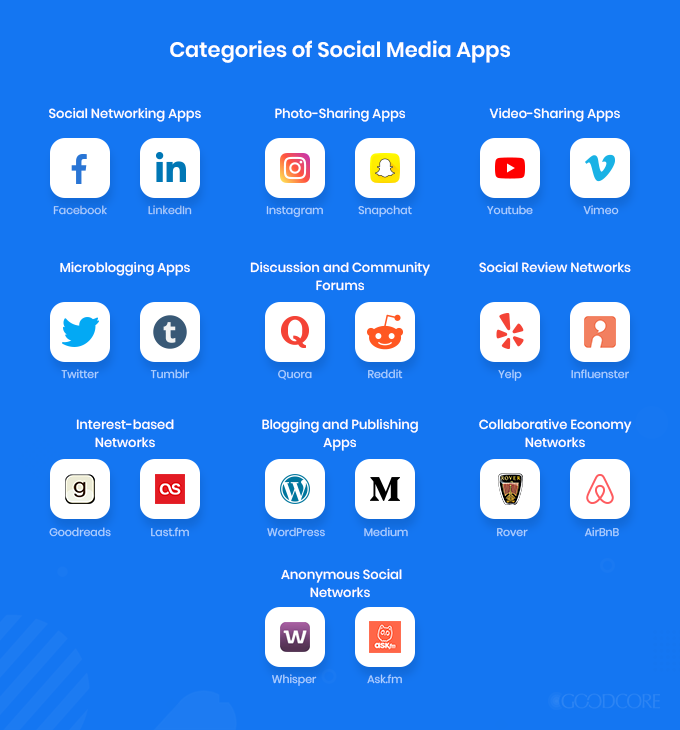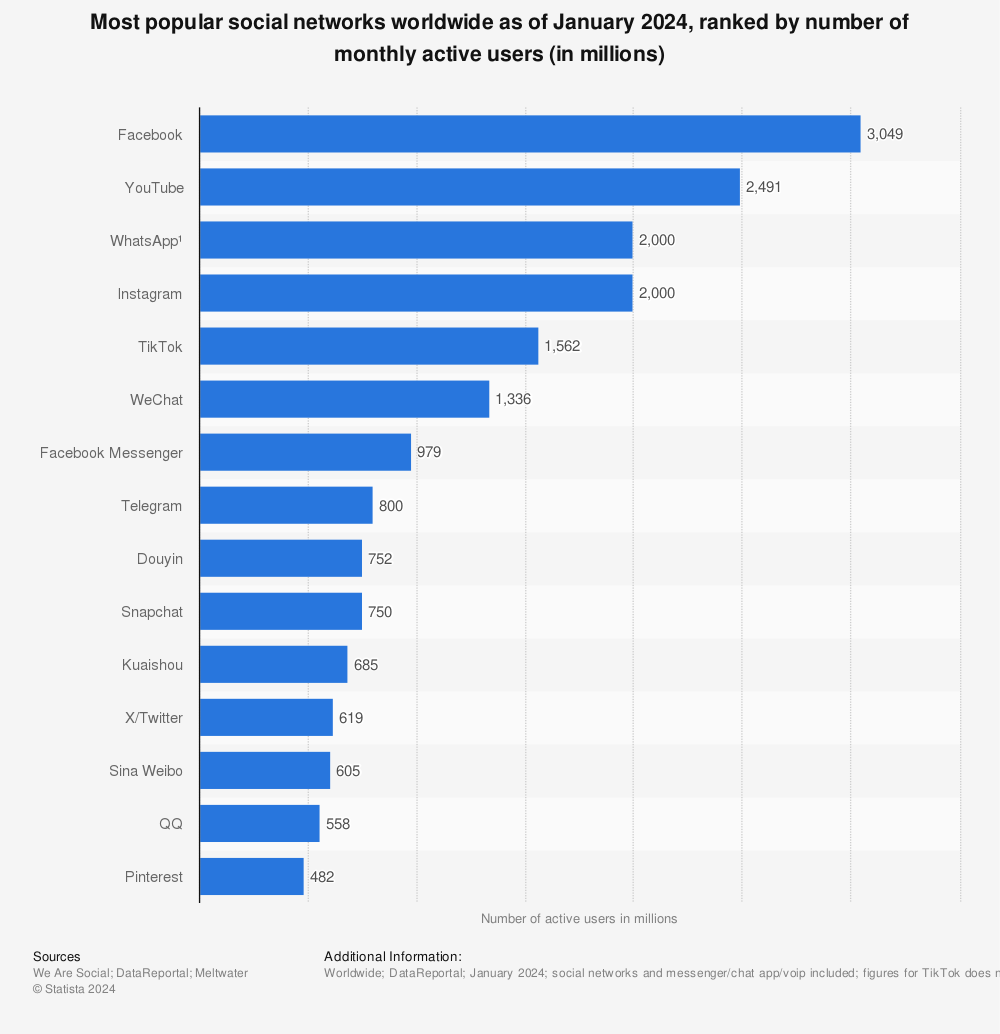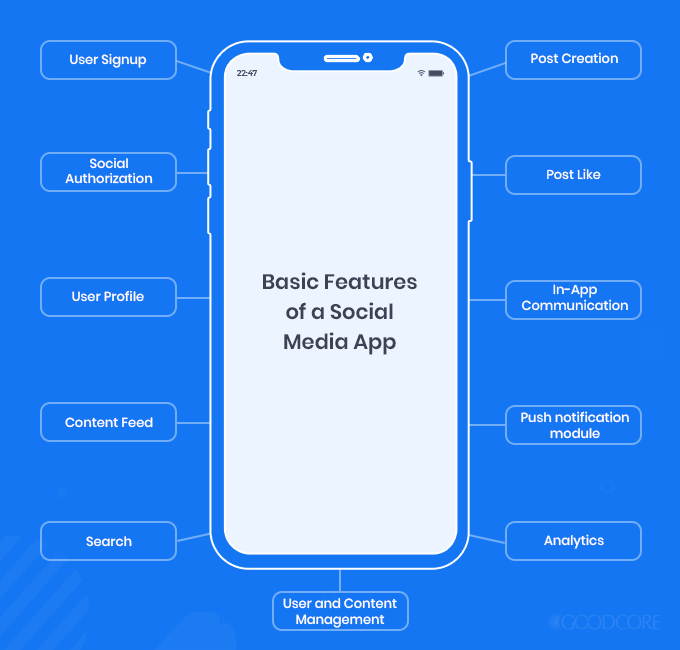How to make a social media app? – That is the first question in the minds of entrepreneurs who want to invest in a social media app. This article is an expert guide for this question, but before we answer, let’s start with asking another important question: Why Social Media?
Social media is not a new phenomenon but it is a niche that always brings forth the newest and most innovative ideas. It is a significant part of the everyday lives of billions of people in the world and, from a business perspective, this makes social media an excellent market for investment. Entrepreneurs have realised the market potential of social media for business and, with the help of professional mobile app developers, successfully launched social media apps to reap the benefits of this promising market.
Innovation and new ideas are at the forefront of social media, and entrepreneurs, especially aspiring startups, have kept the social media game afresh and exciting by launching newer types of social media platforms, with various kinds of innovative content and ways of socialising, and for different kinds of audience segments.
Evolution of Social Media
Social media as we know it today has evolved and changed over the past decades. The first-ever form of social media dates back to the 1970s – yes, you read it correctly! It was nearly two decades before the invention of the World Wide Web when the University of Illinois created a computer system called PLATO (Programmed Logic for Automatic Teaching Operations) systems to facilitate communication between college students. It had features like discussion channels, notes, bulletin boards, and messaging that allowed students access to socialise amongst each other.

Fast forward to 2023, today we have hundreds of social media applications for mobile and web-based platforms. Facebook, Instagram, Twitter, Youtube, TikTok, Snapchat, and LinkedIn, to name a few major players. As social media has evolved, it has also diversified and come far away from PLATO systems. Social media networking apps today are available in multiple languages and enable users to connect with others across geographical, political or economic borders. They also provide a wide variety of types of content and user engagement to people. According to Statista’s latest report, around one-fourth of the world’s population – that is 2 billion people – consists of internet users using social networks. These statistics are still expected to grow with the increase in mobile device usage and the number of social media apps in the years to come.
If you’re wondering how to make a social media app let’s start with asking what kind of social media app you want to develop? You need to begin with understanding the existing social media apps out there – what your app would be up against. So, let’s shed some light on the different categories of social media apps in the next section of the article.
How to Make a Social Media App: Categories of Social Media Apps
Categorising the myriad of social media apps available today into groups based on their purpose and the intended audience is a great exercise to distil your social media app idea further.

1. Social Networking App
Social networking apps are social media platforms created to connect people online. These social networking apps can be for personal networking like Facebook, for professional social networks like LinkedIn, or to date like Tinder.
For social networking apps like Facebook and LinkedIn, all content forms (text, video, image, live videos, and stories) work great and they are designed for people to engage with the content through sharing, comments, and reactions. The features of such social networking apps allow people to engage and build networks with other people with similar interests, for instance, groups, trends, liking pages etc.
2. Photo-Sharing Apps
As the name suggests, photo-sharing apps are social media apps specifically for sharing photo content. Instagram and Snapchat are the two leading photo-sharing social media apps. Since these apps are for photo-sharing, their features and design flow is geared around it, for instance, Instagram’s double-tap like feature, photo editing and filters feature on Snapchat and Instagram, or the grid layout for Instagram.
3. Video-Sharing Apps
Youtube, TikTok, and Vimeo are the most popular examples of video-sharing social media apps. These apps are created for video hosting, viewing, and sharing. Their distinct features like channels, subscriptions, playlists, likes, and comments allow users to view and engage with video content of their interests and customize their feed.
4. Microblogging Apps
Microblogging is a combination of blogging and instant messaging that enables people to share short and instant content with an online audience. Twitter and Tumblr are the leading microblogging social media apps today that enable quick and casual exchange between users. Their unique features like retweets/reshare, threads, hashtag trends, and message word limit are what sets them apart from other social media app ideas.
5. Discussion and Community Forums
Discussion and community forums are another popular category of social media apps that are created for users to ask questions and engage in discussion with other users online. Quora and Reddit are two great examples of discussion and community forums. Such social media apps are more “topic-specific” and they are designed for more textual content.
6. Social Review Networks
Social review networks like Yelp, TripAdvisor, and Influenster are social media platforms used by people to review and share information about products, services, businesses, travel destinations, and more. The value that they offer to people are the reviews as they help people learn from other people’s experience and make informed decisions.
7. Interest-Based Networks
Interest-based social networking apps are social media apps that are specifically built for users with a particular interest or hobby. For instance, Goodreads is a famous interest-based network for people who are interested in reading books. Such social media apps aim to allow people to connect with others around a shared interest and hobby – focusing solely on a single subject only.
8. Blogging and Publishing Apps
Blogging and publishing apps like WordPress and Medium are social media platforms built for people who like ‘blogging’. Such apps allow people to write content and share it with the world and build their own network of readers and followers. These apps are also an important part of the content marketing strategy for businesses so they write and spread the word about their products and services.
9. Collaborative Economy Networks
Collaborative economy networks, also known as ‘shared economy’ networks, are social media platforms to find, buy, sell, share, and advertise products and services. If you have a product or service, for instance, a bed-and-breakfast, a niche network platform like Airbnb can help you reach the target audience for your business. Another example is Rover, which is a niche network for dog owners to find dog sitters and walkers.
10. Anonymous Social Networks
Anonymous social networks are not the most popular kinds of social media apps but they are unique because they allow users to post content anonymously. Two popular examples are the Whisper and ASKfm apps. Such social media apps are meant for fun and casual content and are targeted more toward the younger audience.

Find more statistics at Statista
Based on Statista’s recent report, this is how social media usage varies between some of the top social media apps. Clearly, Facebook is the one that tops the chart but if you are thinking about how to make a social media app that is as successful as Facebook, the answer is to not make an app like Facebook. Instead, come up with an innovative idea and stand out from the rest. And you never know, your app might grow to such heights that the leaders follow as well. Take the example of Snapchat – it was launched in 2011 and it was a one-of-a-kind app that grew so popular that Facebook and the other social media apps owned by Facebook (WhatsApp and Instagram) incorporated famous Snapchat features like stories and AR filters into their social media app. Talking about features, let’s unpack the discussion on social media app features. The next two sections cover the basics of how to create a successful social media app and the features that are all the hype these days.
How to Create a Social Media App: The Must-Have Features to Develop a Basic App
The answer to your ‘how to make a social media app’ question lies in understanding the features of social media apps and differentiating between the basic features of a social media app that absolutely needed to develop a social media app, and the other non-essential but important features of a social media app. Below we have discussed the must-have features of a social media app.

User Signup and Social Authorization
The first must-have feature of a social media app is ‘User Signup’ – which allows people to register for your app and use it. You should always simplify the process of signing up to your social media app, otherwise, if it is a complicated process or involves too many steps, it can become annoying and turn people away. You should always offer more than one way to sign up, for instance, through email and password and/or phone number and password, and offer an option to reset the password too.
Social authorization is another crucial feature for user signup that basically means that users can sign up using their other social media accounts like Facebook or Google. This helps transfer their personal information like full name and profile picture from their other accounts. Developers use technologies like Facebook or Google SDK for this must-have feature.
User Profile
Another must-have feature for how you create a social media app is to have a feature for a user profile that allows users to edit and update their personal information like name, profile picture, location, gender, and more. Every user profile should be searchable so that other users can look them up and it should have options such as contacting the user, sending friendship/following/subscription requests, and viewing their media files or posts.
Content Feed
The content feed feature is one of the main features to consider if you are wondering how to make a social media app. A feed is important because, in most cases, it is the home screen for your social media app where the user lands after logging in. It is where they see posts and updates from other users and stay connected with others. How and what posts show up on the content feed depends on different algorithms and logic that work behind the screen to shape the content feed. It is also important to have a feature to refresh the content feed so users can catch up with the latest posts.
Search Function
Search features help users look up posts, people, and other kinds of content on the social media app. This is an important feature that needs to be done right so that users can search for people and content that they are interested in through tags, keywords, username, location, or any other filters. An efficient and comfortable search function redefines the user experience and makes it easier for users to build their social network by following/liking what they are interested in.
Post Creation
Most social media apps have features to allow users to create their own posts, like Facebook and Instagram, but it can vary depending on the concept of the social media app as well. Depending on your app idea, specific features for post creation are another must-have. A well-thought-out post creation feature that allows users to create posts based on text, images, videos, or geolocation makes the social media app more appealing for users.
Post Engagement
You also need to have some features that allow users to engage with posts, such as the post like/unlike or react feature, the feature to share other users’ posts on your own profile, and the option to comment or reply to comments on the post. These forms of engagement between users and the content are what build the social network and help users interact and socialise with each other.
In-App Communication
Another way for social media app users to interact with each other is through in-app communication features such as direct messages or a chat messenger. A very basic in-app chat should have at least 3 basic functions: (i) write and send messages to other users on the platform in real-time; (ii) a list of all chat messages and message history with time and a user avatar; (iii) push notifications for new message alerts.
Push Notifications
Push notifications for new community posts, engagement on your posts, new messages, new followers/subscribers/friends and similar activity are a way to keep users updated with the newest happenings on the social media app. Therefore, it is advisable to have a push notification module integrated into your social media app so that users stay in the know. Users should also be allowed to change the settings for and subscribe or unsubscribe to push notifications as per their preference.
Analytics
A basic social media app should be integrated with at least some analytical tool like Google Analytics. User analytics reports are necessary for admins to track and evaluate the performance of their social media app. These insights can also guide your marketing strategy to make your social media app more successful. There are a wide variety of paid and free social media tools available that you can consider for your social media app.
User and Content Management
A social media app requires some level of user and content management on the part of the admins. Using CMS tools can help admins manage and filter users and content, registrations, and reported content. It is important to have features for admin login and logout, and to remove and sort out reports and claims.
The aforementioned features are the minimum of what is required to develop a social media application. If you are wondering how to make a social media app that offers more than the basic features, you can always go all-out on additional features and customized design elements to elevate your social media app.
However, if you are considering testing the market with your social media app product then these features are all that you need to develop a Minimum Viable Product (MVP). In the first phase of product development, you can launch an MVP and gather feedback from the market and user base which you can use in the later phases of development to develop the social media app further. This is a well-suited development practice if you are wondering how to create a successful social media app. Especially if your social media app idea is truly innovative and you are unsure about the market response it will receive upon launch.
Looking to develop a Minimum Viable Product?
With over 15 years of experience in MVP development, GoodCore has worked with many startups and businesses as their software partner. We would love to discuss your social media app ideas with you.
Write To Us
How to Make a Social Media App: Some Additional and Trendiest Features
Basic features discussed in the section above are essential features to get you started with a minimum viable product, and once your MVP is successful in the market you can take it to the next level by adding a complete range of additional features. Following are some of the features that are popular amongst social media users today
Augmented Reality and Face Filters
This is a trend that caught up, especially after the success of social media apps like Snapchat. When Snapchat was first launched in 2011, its wide range of augmented reality filters, geo-filters, and added effects became integral to Snapchat’s unique brand identity. Users could easily modify their photos by applying the fun filters and added effects with a swipe and share them with friends. This soon became an interactive and engaging way of communication, especially amongst the younger generation, and took over the traditional messaging. Owing to the huge success of filters and augmented reality, other social media apps like Facebook and Instagram hopped on to the trend and added them to their social media apps.
So if you are wondering how to create a trendy social media app, then adding AR and face filters feature to your app is a good way forward. For this, you need to use specific AR tools and technologies such as the ML Kit and AR Core.
Content Editing
Integrating editing features, especially photo and video editing features, is another way to attract users. Most social apps today including Facebook, Instagram, Snapchat and WhatsApp allow users to edit their photos and videos before posting them online. As an additional feature, you can offer in-app editing features such as rotating and cropping pictures, making collages, snipping videos, or editing the speed and audio tracks of videos.
Live Streaming
Most popular social media platforms like Facebook, Instagram and Twitter have a live videos feature and it is another trendy feature to consider for your social media app. Live streaming connects people in a real-time shared experience where users can stream live videos and chat with other users on live video.
Stories – Ephemeral Content
Ephemeral content is the type of content that stays visible for a limited amount of time (e.g. 24 hours) before it disappears from your feed. Snapchat, Instagram, and WhatsApp stories are some of the most common examples of ephemeral content. Stories are a great way for users to share candid and casual day-to-day events with their followers. That is why they are such a popular feature for social media apps today.
Social Media App Development for iOS vs Android
iOS and Android are the two biggest operating systems and if you want to know how to create a social media app for either of these platforms, then you need to get into the technical differences in the development processes for the respective platforms. Obviously, one major difference is the completely different programming languages for both platforms. When it coinfographicmes to creating social media apps for iOS, programming languages like Swift and Objective-C are used to write the application, whereas, for Android, programming languages like Java and Kotlin are used.
Similarly, different tools and technologies go into developing social media apps for iOS and Android. The following infographics give an overview of the difference in technologies, frameworks, architectural patterns, and more.


Other than the different tools and technologies used for creating social media apps for iOS and Android, another way in which it impacts the development process is the difference in time and efforts that are required for both platforms. When it comes to developing social media apps for Android, in general, it is comparatively more time-consuming and expensive due to the sheer number and kinds of Android devices, which means it requires almost double the amount of effort to optimise the application for a wide range of device and screen sizes. This also becomes pertinent during the quality assurance and testing of the application. Since the number of iOS devices is much smaller than Android’s, it can impact the development duration and cost of development for both of these platforms. This brings us to an essential question that I am sure you must be wondering: How much does it actually cost to develop a social media application? Let’s tackle this question in the next section!
Costs of Creating a Social Media App
When it comes to the costs of developing any kind of app, be it a social media app or a fitness app, there are several factors in play that determine the final cost. In the end, it boils down to the idea of the app itself, the design workflow, the number of features, the size of the intended user base, and pages (or what the developers refer to as ‘screens’) of the application. The more the number of pages, the more it costs.
As per GoodCore Software’s pricing policy, a basic social media application or MVP can cost anywhere between £10,000 – 65,000, and a full-scale social media application with added features can cost upwards of £70,000.
However, these price ranges are based on rough estimates; the actual cost of development can vary based on many factors.
Estimate the cost of your social media app project
For precise estimates for your social media app, get in touch with us and our analysts will get back to you with a realistic quote for your project.
Write To Us
Wrapping up Our Guide on How to Create a Social Media App!
From a business point of view, the market potential of social media is huge and attractive for entrepreneurs. Many entrepreneurs, especially startups, aim to enter the market with innovative social media apps but a major difficulty that they face is ‘How to make a social media app?’ Being in the mobile app development industry for more than 15 years, we can safely say that creating a social media app that is innovative and market-competitive is not an easy task!
I hope this guide has provided you with a substantial understanding of the most important factors to consider when creating a social media app. So let’s wrap up our discussion with a quick checklist of best practices for how to create a successful social media app.
Best Practices to Consider
- It all begins with a good idea: A successful social media app is always a product of a brilliant and creative idea. So focus more on coming up with social media app ideas that are fresh and new. The more you think your idea through, the more likely you are to come up with the next big thing in the world of social media.
- Work out the features and design workflow of your app: Coming up with a mere idea of what you want from the app is never going to be enough. Instead, think about your app as a complete brand and work out the features and design that works in line with the brand image you want to create.
- Good marketing = greater success (always!): A successful social media app is not only an app that is well-developed and offers bug-free performance, but it is an app that is well marketed. Marketing and developing the app are both equally important for the success of the social media app.
- Test to gather feedback: As with any innovative app idea, it is always advisable to test out the product in the market to gather feedback from the users. Phasing out the development process and releasing an MVP prior to developing a full-scale product help you do that.
Get expert advice on developing your social media app’s MVP!
We would love to hear app ideas and give you advice on how you can go about developing your own social media app.
Write To Us
- Look for an experienced development team: Having an experienced development team by your side can make or break your social media app’s chances of success. Whether it is an in-house team of developers or an outsourced one, you need to ensure that you have a team that is experienced in this niche of app development, and that can expertly visualise your idea into a functioning product.





